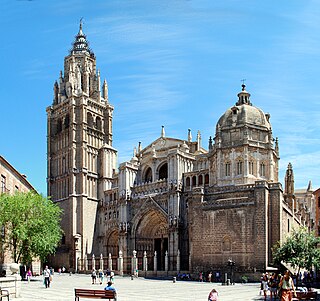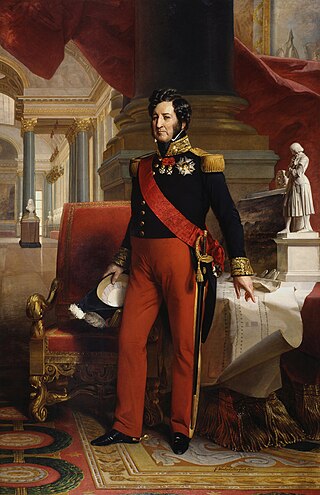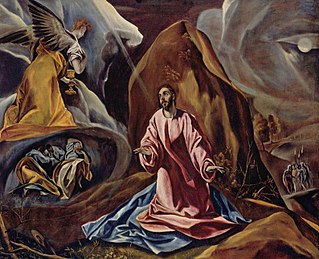
Domḗnikos Theotokópoulos, most widely known as El Greco, was a Greek painter, sculptor and architect of the Spanish Renaissance. El Greco was a nickname, and the artist normally signed his paintings with his full birth name in Greek letters, often adding the word Κρής, which means "Cretan".

The Spanish Renaissance was a movement in Spain, emerging from the Italian Renaissance in Italy during the 14th century, that spread to Spain during the 15th and 16th centuries.

The Disrobing of Christ or El Expolio is a painting by El Greco begun in the summer of 1577 and completed in the spring of 1579 for the High Altar of the sacristy of the Cathedral of Toledo, where it still normally hangs. In late 2013 it was on temporary display at the Prado in Madrid, following a period of cleaning and conservation work there; it was returned to Toledo in 2014. It is one of El Greco's most famous works. A document dated July 2, 1577 which refers to this painting is the earliest record of El Greco's presence in Spain. The commission for the painting was secured thanks to El Greco's friendship from Rome with Luis, the son of Diego de Castilla, the dean of the Cathedral of Toledo. De Castilla senior also arranged El Greco's other major commission, on which he worked simultaneously, the paintings for the Toledan church of Santo Domingo el Antiguo.

The Primatial Cathedral of Saint Mary of Toledo, otherwise known as Toledo Cathedral, is a Roman Catholic church in Toledo, Spain. It is the seat of the Metropolitan Archdiocese of Toledo.

The Monastery of Saint Dominic of Silos (the Old) (Spanish: Monasterio de Santo Domingo de Silos (el Antiguo)) is a Cistercian convent in Toledo, Spain.
Nicolás de Vergara el Mozo was a Spanish sculptor, architect, blacksmith and glassmaker. He worked in the Toledo Cathedral, where he was master of works, and in other religious and civil buildings. He was the son of the architect and sculptor Nicolás de Vergara el Viejo and Catalina de Colonia, and brother of Juan de Vergara. He was also the nephew of the master glassmakers Arnao de Vergara and Arnao de Flandes and grandson of Arnao of Flanders the Elder.

Saint Peter and Saint Paul is a painting by the Cretan-Spanish artist El Greco. The work was completed between 1590 and 1600. It is currently on display at the Museu Nacional d'Art de Catalunya, who purchased the work in 1932.

The Museum of Santa Cruz is an art, archaeology and ethnographic museum located in the historic centre of the city of Toledo, Spain. It exhibits collections pertaining to the province of Toledo, including works painted by El Greco in the city of Toledo.

The El Greco Museum is located in Toledo, Spain. It celebrates the mannerist painter El Greco, who spent much of his life in Toledo, having been born in Fodele, Crete.

The Spanish gallery, also called Spanish museum was a gallery of Spanish painting created by French King Louis Philippe I in 1838, shown in the Louvre, then dismantled in 1853.

The Palacio del Marqués de Malpica is a building in the city of Toledo, Castile-La Mancha, Spain. It's located at the Plaza de Santa Clara and next to the monastery of the same name. It is of Renaissance style and belonged to the Marquis of Malpica y Valdepusa.

Christ Bearing the Cross is a 1590-1595 painting by El Greco.

Agony in the Garden is a 1590 oil on canvas painting by El Greco or his studio, dating to his second stay in Toledo and still showing the major influence of Titian on his work. It is now on display in the Toledo Art Museum in Toledo, Ohio.

Holy Family is a 1586-1588 oil on canvas painting by El Greco, painted during his time in Toledo and now in that city's Museum of Santa Cruz.

Portrait of Antonio de Covarrubias is a 1595-1600 oil on canvas painting by El Greco, dating to his time in Toledo. It is now in the Louvre in Paris as the result of an exchange with Spanish museums in 1941.

Christ Carrying the Cross is an oil painting by El Greco, produced early in his Toledo period circa de 1580. The picture depicts Christ in a moment of personal reflection as he carries the cross to his death, therefore committing the ultimate sacrifice for humankind. In the painting, Christ's eyes are lifted up to the heavens as he begins his walk towards his crucifixion. His gentle hands wrap around the cross as a stormy night floods the background. Christ Carrying the Cross is an oil painting, 105x79cm. The painting, one of numerous similar paintings by El Greco, is currently in the El Greco room in the New York art collection of the Metropolitan Museum of Art.
Christ Carrying the Cross refers to Jesus's journey to his crucifixion.

Allegory of the Camaldolese Order is a composition by El Greco and his workshop that survives in two paintings, one at the Instituto Valencia de Don Juan in Madrid and the other at the Museo del Patriarca in Valencia. The paintings depict a bird's-eye view of the "ideal monastery" according to the Camaldolese, and were likely commissioned as part of Fray Juan de Castañiza's petition to Philip II in 1597 to establish the benedictine monastic order in Spain.

















